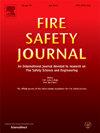排风口泄漏对隧道排烟效率的影响分析
IF 3.4
3区 工程技术
Q2 ENGINEERING, CIVIL
引用次数: 0
摘要
海底公路隧道的通风段非常长。排烟口漏风严重降低排烟系统的工作效率,威胁人员的生命安全。本文建立了排气管泄漏计算模型,并通过现场试验验证了计算模型的可靠性。采用普通排气孔时,箱体隧道漏风量达到155.22 m3/s,使排烟口气流的抽气效率(抽气效率)降低40%以上;漏风的影响是不容忽视的。在相同排烟量下,随着泄漏系数K0由3增大到24,排烟效率由89.59%降低到47.86%。随着排烟口数量的减少,隧道的抽烟效率降低。当排烟间距由50 m增加到90 m时,抽烟效率由52.51%提高到69.35%。该计算模型考虑了排烟口泄漏,对评价排烟系统的效率和优化隧道防火安全设计具有重要意义。提出了全隧道排气口泄漏预测公式。本文章由计算机程序翻译,如有差异,请以英文原文为准。
Analysis of the influence of exhaust vent leakage on the efficiency of tunnel smoke evacuation
The ventilation section of an undersea road tunnel is extremely long. Air leakage from the exhaust vents significantly reduces the efficiency of the smoke exhaust system, which threatens the lives and safety of personnel. In this paper, a calculation model of exhaust vent leakage is established and the reliability of the calculation model is validated by field tests. Air leakage in the case tunnel reached 155.22 m3/s with a common type of exhaust vent, reducing the extraction efficiency of gas flow through smoke vents (extraction efficiency) by more than 40 %; the impact of air leakage cannot be ignored. The extraction efficiency of the exhaust vents is reduced from 89.59 % to 47.86 % as the leakage coefficient K0 increases from 3 to 24 for the same smoke exhaust volume. As the number of opened smoke vents decreases, the extraction efficiency of the tunnel decreases. When the smoke vent spacing increases from 50 m to 90 m, the extraction efficiency increases from 52.51 % to 69.35 %. The proposed calculation model, which considers exhaust vent leakage, is important for evaluating the efficiency of the smoke exhaust system and will help to optimize the tunnel's fire safety design. An exhaust vent leakage prediction formula of the whole tunnel is also proposed.
求助全文
通过发布文献求助,成功后即可免费获取论文全文。
去求助
来源期刊

Fire Safety Journal
工程技术-材料科学:综合
CiteScore
5.70
自引率
9.70%
发文量
153
审稿时长
60 days
期刊介绍:
Fire Safety Journal is the leading publication dealing with all aspects of fire safety engineering. Its scope is purposefully wide, as it is deemed important to encourage papers from all sources within this multidisciplinary subject, thus providing a forum for its further development as a distinct engineering discipline. This is an essential step towards gaining a status equal to that enjoyed by the other engineering disciplines.
 求助内容:
求助内容: 应助结果提醒方式:
应助结果提醒方式:


